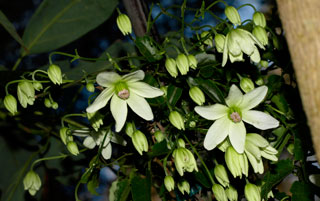NOTE - THIS PROTO-PAGE IS STILL IN THE VERY EARLIEST STAGES OF CONSTRUCTION!
While it is flowering the pua wänanga is one of the most spectacular of New Zealand plants, with mature vines bearing hundreds of large, white scented flowers festooning the treetops like stars in the sky. This "flower of learning" is the child of two stars, Rëhua (Antares, the sign of summer) and Puanga (Rigel) the star of the harvest -- Pua Wänanga, their child, thus signals that spring is here, time for planting for the season of plenty to come.
The history of the word pua and its derivatives is summarized on the linked page devoted to Proto Polynesian *Pua. In Aotearoa its ancient meanings are reflected strongly in the pua wänanga, with its masses of showy, scented flowers, and in the alternative name for the Tï-kouka, Tï-pua, which similarly bears great bunches of panicles with heavily scented flowers, about the time the pua wänanga finishes flowering.
Another alternative name for Clematis paniculata is puapua. This reduplicated form was applied especially to a particular tree, Guettarda speciosa, in Proto Eastern Oceanic, and in Proto Eastern Polynesian the generic meaning of *pua was extended to denote blossoms in general. In Maori this latter meaning has been retained, and puapua has acquired the meaning of "wreath", and also Clematis paniculata, the blossoms of which, when available, were especially valued for this use.
A few other species of plants also have been given names incorporating the word pua and the derivative form puapua in Aotearoa. These are the köpuapua, Cordyline pumilo (also known as tï-köraha), which has masses of very sweetly scented flowers in Spring, the puatawhiti, Metrosideros fulgens [Myrtaceae], a climbing rätä with spectacular orange-red petals and scarlet stamens, and two species of daisies, Anaphalioides trinervis (puatea) and Craspedia lanata [Asteraceae] (puatororaro), whose unopened flower buds are perhaps reminiscent of some of the tropical pua, to which otherwise they bear no obvious similarity, to this observer, at least. More likely, the "pua" element in these names refers to the derived meaning of "flower, blossom" rather than to the earlier connotation of a plant bearing spectacular, sweetly perfumed flowers.
Clematis paniculata is also known as pikiarero, püänanga, puatataua ~ puatautaua (along with C. hexasepala), and with many other climbers is classified as one of the pöhue (see linked page).
Further information: The New Zealand Plant Conservation Network's site has many pictures and comprehensive information about Clematis paniculata, and it is also featured on the University of Auckland's Biological Sciences website.
The NZPCN site also has pages on Anaphalioides trinervis and Craspedia lanata.
![]()
 This work is licensed under a Creative Commons Attribution-Noncommercial 3.0 New Zealand License.
This work is licensed under a Creative Commons Attribution-Noncommercial 3.0 New Zealand License.

